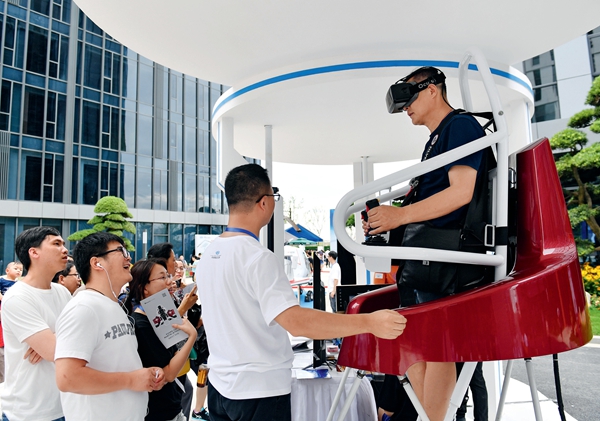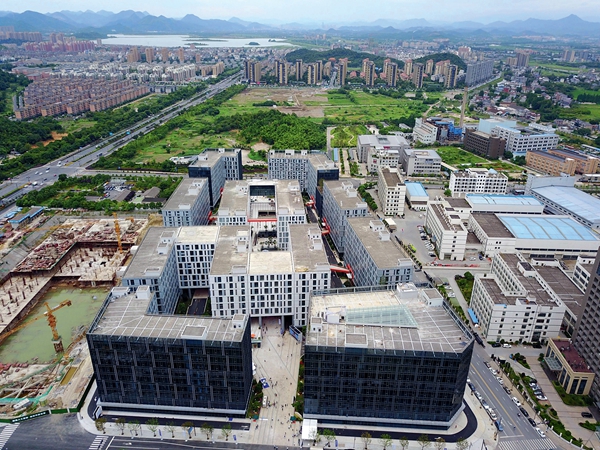By XIONG HONGRU
By XIONG HONGRU
ACCORDING to President Xi Jinping, the basic ingredient that makes a nation competitive is innovation. Since the 18th National Congress of the Communist Party of China in 2012, China has deployed several major policies to implement an “innovation-driven development strategy.” This move will foster innovation in the Chinese people – innovation that will be the new fuel for China’s economic growth, helping the country to transform and upgrade itself in the time of the economic “new normal.”
A Major Factor in Modernization
Rather than being a short-term or makeshift solution, China’s innovation-driven development strategy is a key factor of its modernization. “To boost innovation is to boost development, and to plan for innovation is to plan for the future. Unwilling or slow to innovate, we will lag behind,” stressed President Xi. This strategy plays an irreplaceable decisive guiding role for China’s economy at the new normal stage.

Innovation spurs modernization by speeding up economic and social development. By moving away from the growth model that depends excessively on input of production elements, and by lessening the restraint on economic growth by resources, environment and market demands, innovation is the best way to achieve sound, sustainable economic development.
Judging by the experience of more innovative, developed countries, innovation not only brings about new ideas and technologies, but also gives a huge boost to export, employment and business opportunities. China has now entered a stage of relying on innovation to achieve sustainable development. For a number of impressing issues that face China, ranging from its excess production capacity and the international technological monopoly to middle-income trap, innovation is needed to transform the nation’s development models, promote structural optimization, and improve development quality and efficiency.
Innovation is essential for this new technological and industrial revolution. It is key to shaping the world economic structure and patterns of competition. As well as integrating manufacturing with new technologies such as mobile Internet, cloud computing, big data, 3D printing and artificial intelligence, the new technological revolution has become the primary factor in determining a country’s competitive edge. A large capacity for innovation will change the course of development and set the rules for an industry. A real economic power isn’t just an economy of larger size, but also an economy of strong innovative capacity and superlative structure.

During this transitional period, the obvious reason for slower economic growth is the huge surplus of outdated capacity, the decline in business revenues, and the withering real economy. The underlying cause, however, lies in the current flawed supply structure and the poor quality of supply that cannot meet a fast growing and increasingly diverse demand.
As China’s innovation ability has increased over the past few decades, the space for traditional technology to catch up is decreasing, and the bonus of resource allocation brought by the last round of reform and opening-up is wearing off. Therefore, China not only needs to further open up its market to create more investment opportunities with a new round of deep, comprehensive economic reforms, but should also promote entrepreneurship and innovation among its people, encouraging new business models and governance mechanisms. The country needs to tap into new sources of economic growth in order to speed up its momentum and further its economic restructuring and upgrading.
The Implications and Progress of Innovative Development
Among the five development concepts of China’s 13th Five-Year Plan, innovation ranks the first. Since the country’s economic development entered the “new normal” stage, China has entered a key transformation period characterized by innovation-driven development.
As a national strategic requirement, innovation is a main area to serve economic and social development and better guide the new normal. An innovative development mode is the catalyst that will help the current economic system evolve under new technological economic conditions. Innovation is needed to create new driving force for growth by achieving a radical transformation of the development model.
As the cost of production elements continues to rise, it is necessary to use technological innovation to increase productivity, tackle resource and environmental constraints, and improve development quality. Looking at consumer needs, it is necessary to depend on innovation to expand effective supply and satisfy diverse consumer demands. To deal with the pressure of environmental and energy constraints, it is necessary to pursue green development using advancements in technology. It is important to optimize regional innovation, build regional economic growth poles and promote balanced development. It is important to adopt a global vision for innovation, effectively utilize global innovation re-sources, and improve China’s competitive position globally.
Innovation-driven development is a comprehensive move with scientific and technological innovation as its core, which must be accompanied by institutional innovation. One aim of technological innovation is to grasp core technology, improve the capacity for homegrown innovation and achieve technological independence. Adopting “asymmetric” overtaking strategy, technology should guide industrial transformation and development with a wider range of applications. It is also necessary to encourage the development of new technologies, new products, and new business modes to move the focus of economic development from speed and scale to quality and efficiency, adding new vitality to economic growth.
Meanwhile China must continue to open up and reform to create innovation-friendly mechanisms and policies. We should cultivate an innovative market to promote quality and mobility, offer adequate incentives to attract talented people, and fuel enthusiasm for innovation in society. We should also give play to the market’s guiding role in technological research and development, pricing of raw materials and other factors in order to increase efficiency.
Under the “new normal,” China’s innovation-driven development has entered a new stage. The nation’s science and technology capability has moved away from following others towards a new mix of following, advancing together and taking the lead. The target has changed from achieving breakthroughs in a few specific areas, to the improvement of overall capability. Innovation now involves not just scientific and technical personnel but all of society. The industrial value chain has moved from low end to mid-to-high end, and the innovative model has shifted from learning through import to original innovation; from being relatively closed to being much more open.
The meaning of innovation-driven development is not confined to the material level, but is also a systematic development strategy covering systems and technology. Theoretical innovation, institutional innovation, technological innovation and cultural innovation jointly constitute China’s innovative development concept. This clearly shows China’s development direction and requirements, which follows the trend of world development, and embodies the Chinese government’s grasp of the law of economic and social development.
Strategic Measures and Key Tasks
The outline of China’s innovation-driven development strategy was released in January 2016, formally putting forward the three steps necessary for reaching the strategic target of building a powerful country of scientific and technological innovation by 2050.
To become an innovative power will require systematic changes, which can’t do without clear strategic thinking. To follow the outline, China will integrate reform and development, focus on increasing economic competitiveness, meet the need for social progress and tackle the big challenge of national security, adopt a differentiation strategy, and promote strategic deployment in key areas.
To achieve this, the outline puts forward eight strategic aims, namely: to further industrial technology system innovation, gain a new advantage in development; encourage home-grown innovation, enhance emerging strategic industries; optimize regional innovative layouts, build regional centers for economic growth; deepen military and civilian industries integration, facilitate innovative interaction; expand the public participation in innovation, guide innovative development; implement major scientific projects to achieve key breakthroughs; create a pool of high-level talent, consolidate innovation foundations; promote innovation and entrepreneurship, and inspire creativity in the whole of society.
To further enforce the innovation-driven development strategy, the key task at this stage is quite clear. According to the 13th Five-Year Plan, China will implement a framework for a development pattern prioritizing innovation. Promoting innovative development not only requires technological innovation, but also needs significant reforms, institutional innovation and management innovation. In the reform and innovation process, we should optimize the allocation of resources such as labor, capital, land, technology and management, encourage public entrepreneurship and innovation, improve the supply structure, and promote economic transformation and upgrading. The top priority is to speed up the construction of an institutional framework and ecological environment beneficial to innovation, and further encourage social innovation.
Over the last few years China’s innovation policy has moved from a focus on technology to a more integrated policy system, paying more attention to the market and the allocation of resources for the purpose of innovation. The government will continue to play an upright and efficient role in this economic transition.
There is a long way to go before China becomes a great innovative power. On the one hand, China will further transform its innovation governance pattern from being government-led to one where the government and market play their due roles respectively, effectively giving play to market mechanisms in the allocation of resources for innovation, and bringing in government regulations wherever the market fails to work.
On the other hand, China will keep increasing the capacity for innovation of its enterprises, translate innovation into productivity, constantly enhance the technological supply and capacity for homegrown innovation, integrate with the global innovative network, effectively use international innovation resources, and raise the efficiency and quality of the state innovation system.
XIONG HONGRU is an associate researcher at the Innovative Development Research Department of the Development Research Center of the State Council.